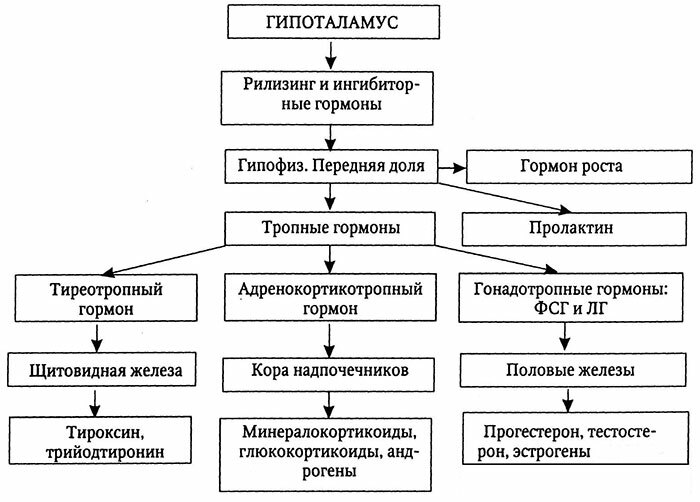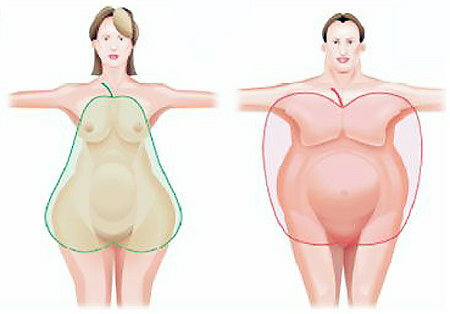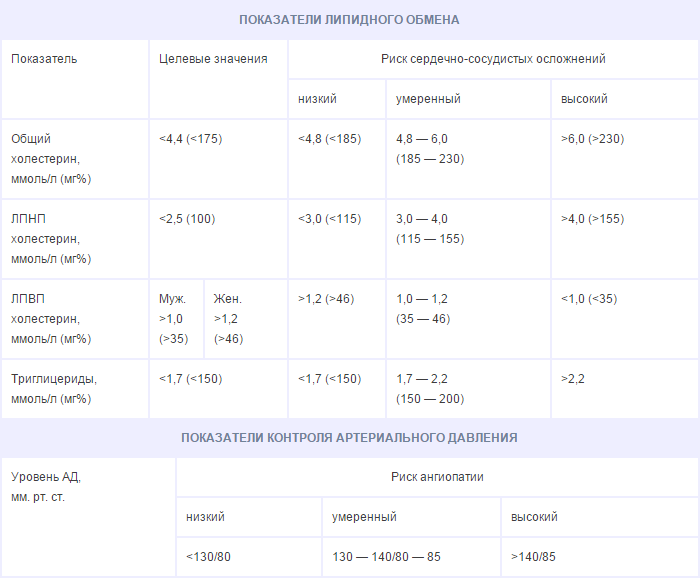Gonadotropic hormones
Gonadotropin hormones( gonadotropins) - follicle-stimulating( FSH) and luteinizing( LH) hormones secreted by the anterior pituitary gland and having a regulatory effect on the testicles. Gonadotropins provide hormonal regulation of testosterone synthesis by Leydig cells( steroidogenesis) and the formation of spermatozoa( spermatogenesis), that is, the reproductive function of a male. Clinical practice shows that there may be an isolated impairment of spermatogenesis with the preservation of steroidogenesis, and vice versa.
Contents
- 1
- 2 Regulation
- 2 regulation Luteinizing hormone
- 3 Follicle stimulating hormone
- 4 Diagnostic use of gonadotropins
- 5 Therapeutic use of gonadotropins
The
regulation mechanism The pituitary gland stimulation for gonadotropins is produced by the gonadotropin-releasing hormone( GnRH) secreted by the hypothalamus( Figure 1).GnRH secretion is not permanent but episodic, with equal intervals of hormone secretion, which determines the rhythm of LH and FSH secretion. The intensity of the secretion of gonadotropic hormones in the pituitary gland depends on the level of secretion of androgens and inhibin, which, according to the feedback principle, inhibit the production of gonadotropins. For example, the more testosterone in the body, the more intense is the inhibition of LH production. This feature allows you to diagnose various forms of hypogonadism: with primary hypogonadism, the level of LH is elevated, while in the secondary hypogonadism it is lowered. Apparently, only the bioactive form of testosterone, not associated with SHBG, has an inhibitory effect.

Fig.1 - Regulation of the hypothalamic-pituitary system of endocrine glands functioning.
It is believed that in the implementation of the mechanism of the inhibitory effect of testosterone on LH not the hormone itself but its active metabolite dihydrotestosterone( DHT) or estradiol participates. It is known that the suppression of LH secretion requires much less exogenous estradiol than testosterone or DHT.The mechanism of the inhibitory effect of estradiol on LH determines the key factor in reducing the secretion of sex hormones in male obesity, since fat tissue provokes the activity of the aromatase enzyme, which increases the content of estrogens.
Luteinizing hormone
Luteinizing hormone in the body acts as the main and sole stimulator of synthesis and secretion of testosterone by Leydig cells of the testes. Receptors for LH and chorionic gonadotropin( HG) are found only on Leydig cells. Testosterone and DHT, suppress the secretion of LH on the principle of feedback. With a deficiency of testosterone, the secretion of LH by the pituitary gland increases. Oppresses the secretion of LH estrogens, as well as the hormone adipose tissue leptin, so in men with abdominal obesity with a low level of testosterone there is no increase in LH.Violated secretion of LH and hyperprolactinemia, hypercortisy, tumors of the pituitary gland.
Prolactin, previously considered as another gonadotropin, in the presence of LH is necessary to enhance the activity of Leydig cells for producing sex hormones, since it promotes an increase in receptors for LH.This applies only to the normal level of prolactin, which does not exceed physiological concentrations, - an increased level of prolactin depresses the function of the testes. Read more "LH for men - function, norm and pathology".
Follicle stimulating hormone
FSH in men regulates the function of spermatogenesis in the testicles. Under the influence of FSH, differentiation of spromatogonia occurs in the germinal epithelium of the seminiferous tubules of the testicles. The interaction of FSH and spermatogenic epithelium is realized, it is believed, by inhibin B, produced in Sertoli cells of the testes. Receptors for FSH in the testicles are found only on Sertoli cells.
FSH, unlike LH, does not affect the synthesis of androgens, but it is believed that it provokes the appearance of LH receptors, which allows to increase the reactivity of Leydig cells in relation to LH.Androgens in physiological concentrations are necessary to ensure normal spermatogenesis.
It is noted that high doses of testosterone( for example, when using high doses of hormonal drugs) are able to inhibit FSH.The levels of testosterone and DHT, which are in physiological limits, do not have such an effect. The estrogens suppress the secretion of FSH even more intensively than the secretion of LH.This may be one of the reasons provoking male infertility in obesity.
Concentration of FSH in the blood is a marker of safety of the spermatogenic function of the testes. The extremely high( postcastral) level of FSH blood indicates an irreversible impairment of spermatogenesis.
Read more «FSH in men - function, norm and pathology».
Diagnostic use of gonadotropins
Quantitative measurement of the level of LH and FSH is necessary to verify steroidogenic functions of the testicles. Low levels of gonadotropins in men indicate a pathology of the hypothalamic-pituitary system, which is secondary( hypogonadotropic) hypogonadism. Primary( hypergonadotrophic) hypogonadism is characterized by elevated levels of LH and FSH, and indicates a disruption in the testicle.
To test the steroidogenic function of Leydig cells in the testes, a test with CG is carried out. After several daily injections of HG, measure the amount of testosterone in the blood( usually the day after the last injection), and compare it with the results obtained before the sample. The procedure for the HG-test may differ depending on the method chosen. An increase in the testosterone level of more than 50% indicates the safety of the steroid function of the testicles, and indicates a pathology of the hypothalamic-pituitary system. A slight increase in androgens in the blood or complete absence of changes indicates a loss of functions for the synthesis of sex hormones by Leydig cells.
Therapeutic use of gonadotropins
For therapeutic purposes, chorionic gonadotropin preparations with effects of both LH and FSH are used, but with a significant predominance of the effects of luteinizing hormone. It is noteworthy that luteinizing activity of CG exceeds the activity of "natural" LH produced by the anterior lobe of the pituitary gland.
Read more «Stimulating therapy with chorionic gonadotropin».
HG can be used in men for treatment:
- hypogonadotropic( secondary) hypogonadism;
- male infertility and disorders of spermatogenesis;
- cryptorchidism;
- androgen deficiency induced by age-related changes.
Sources:
Kalinchenko S.Yu., Tuzikov IA, "Practical Andrology", 2009
Dedov II, Kalinchenko S.Y., "Age androgen deficiency", 2006
Recommended for viewing:


